


A newsletter for modern marketers.

TRUSTED BY THE WORLD'S SMARTEST MARKETERS
Free ad performance benchmarks every week.
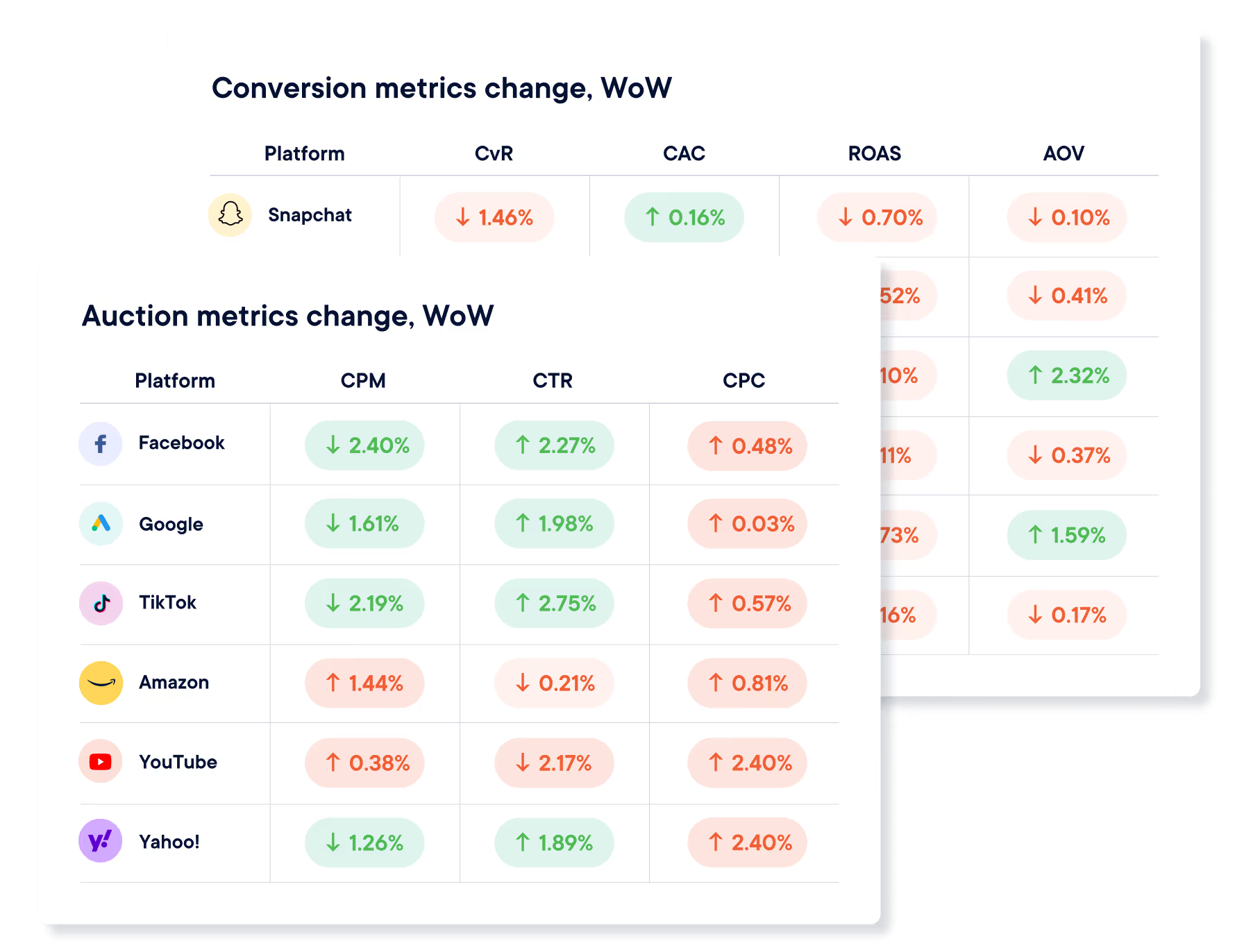
Live webinars and strategy sessions with industry leaders.
Watch all previous episodes on our YouTube channel.
Insider strategies from the smartest brands in ecommerce.
SEE LATEST POSTS:

Gamification Marketing: Using Game Mechanics to Boost Ad Engagement & Attribution

Gamification has moved far beyond loyalty apps and mobile games.
Today, paid media teams are deliberately placing game mechanics in ads to capture attention, boost engagement, and generate richer data.
Instead of asking users to watch an ad, gamified formats invite them to participate in it, and every tap, swipe, or completion event becomes a measurable signal.
In this article, we break down what paid advertising gamification is and how it strengthens attribution by creating more behavioral touchpoints.
You’ll learn which game mechanics matter most, how to map them to attribution metrics, and how to design a gamified campaign that is both fun for users and cleanly trackable for analysts.
We’ll also explore key trade-offs such as tracking complexity, novelty fade, spill-over effects, and the difference between interaction and true incrementality. Finally, we wrap with actionable steps your paid media and attribution teams can use to launch a pilot, measure lift, and scale gamification responsibly.
If you’re looking for a clearer way to understand which ad interactions drive real value, gamified formats offer a promising path.
Why Gamification Works in Paid Ads & Attribution
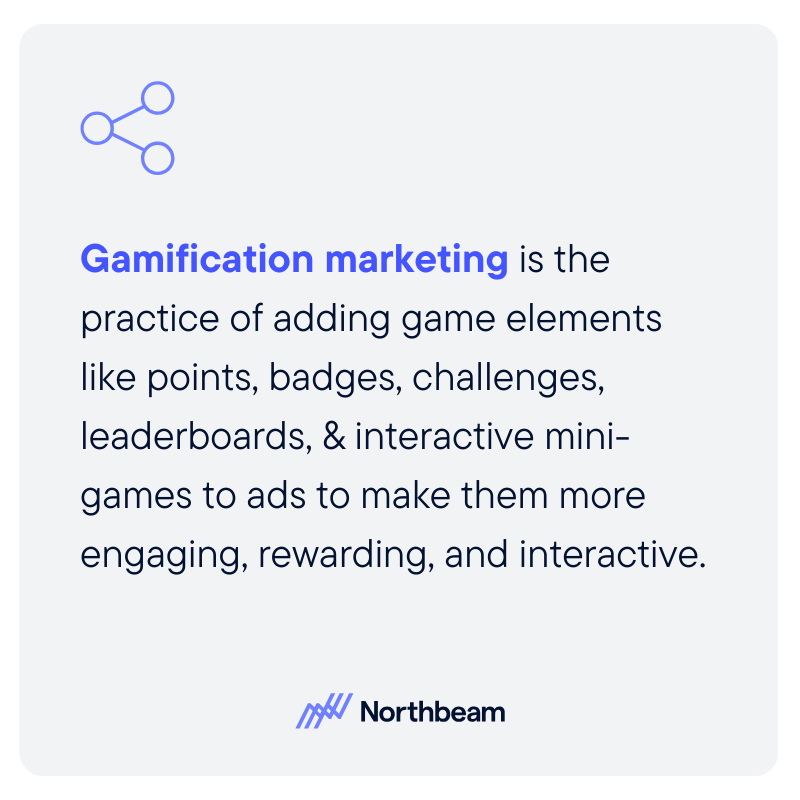
Ad engagement gamification in advertising means adding game elements like points, badges, challenges, or leaderboards directly into an ad to make it more engaging, rewarding, and interactive.
Instead of watching or scrolling past an ad, users get something to do. That small shift turns a passive impression into an active, measurable interaction.
These mechanics work because they naturally increase ad engagement. A playable ad or short interactive challenge keeps users on the creative longer, which improves dwell time, boosts click-through rates, and often leads to higher completion rates.
Some studies, such as the Oppizi benchmark, show engagement lifts of up to roughly 48% for gamified formats.
When users stay longer and do more inside the ad, platforms receive stronger behavioral signals that help the system optimize delivery.
Gamification also enriches event data. Every tap, swipe, choice, or level completion becomes a micro-interaction you can track.
Instead of attributing value to a single click, paid media teams gain a full sequence of user actions inside the ad.
These additional touchpoints clarify how users move from exposure to exploration to conversion, which improves the accuracy of multi-touch attribution models.
In short, gamified ads don’t just make creatives more fun. They generate more data, better signals, and clearer behavioral pathways.
This gives attribution systems more to work with, helping marketers understand which interactions actually drive value and where to invest next.
Core Game Mechanics for Ad Campaigns & How They Map to Attribution Metrics
Gamified ads use familiar game mechanics to turn standard creatives into interactive experiences.
Each mechanic creates its own behavioral signals, which can be tracked as micro-conversions and linked directly to downstream outcomes. The more intentional the mechanic, the stronger the attribution clarity.
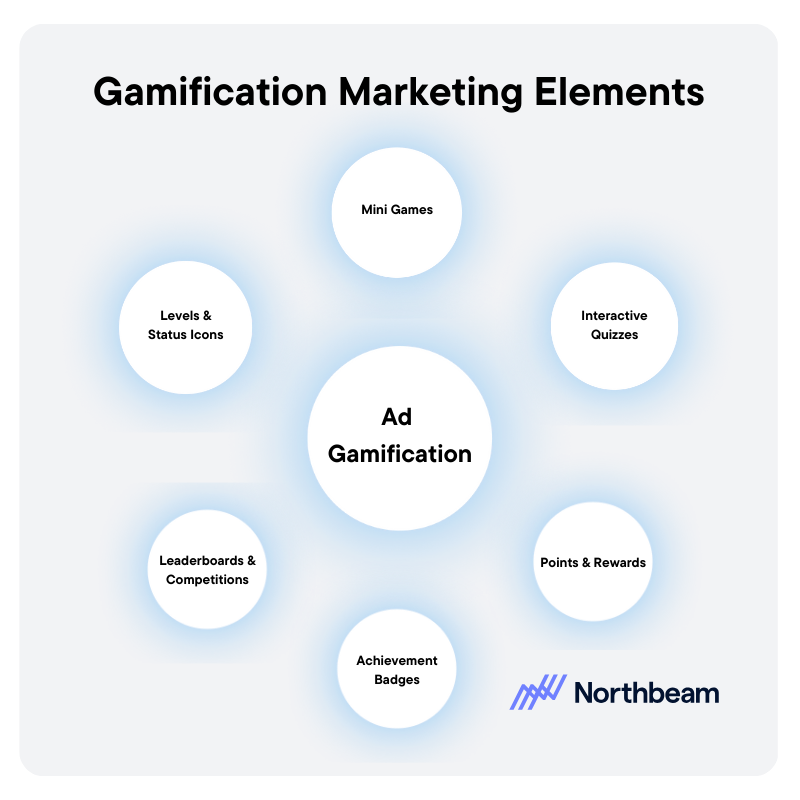
Here’s how to use gamification in paid advertising campaigns:
Playable Ads, Interactive Quizzes, and Mini Games
Playable formats give users something to do rather than something to watch. When someone completes a quiz or finishes a 30-second mini-game, they generate high-quality events such as completed game, earned badge, or claimed reward.
These signals usually correlate with stronger intent, which can make your attribution model more confident when assigning value to later clicks or conversions. They also boost KPIs like interaction count, completion rate, and time spent in the ad.
Points and Rewards Systems
Points create a lightweight incentive loop. Users earn points for behaviors like viewing the ad, completing an action, or clicking through.
Because each point-earning action is trackable, these become micro-conversions that map neatly into multi-touch attribution models.
Reward mechanics can also highlight which steps of the funnel are most motivating, improving attribution across metrics like completion depth, click-through rate, and eventual purchase rate.
Badges, Levels, and Status Icons
These mechanics recognize milestones, such as a user’s first interaction, first purchase, or fifth referral.
Badges and levels produce identifiable behavioral segments that matter for attribution. For example, “badge earners” may show a meaningfully higher likelihood to convert or return later.
Tracking these milestones allows paid media teams to understand repeat value and tie long-term outcomes back to earlier gamified interactions.
Leaderboards and Social Competition
Leaderboards encourage users to share, invite friends, or replay the ad to improve their score. This introduces referral and social-spillover touchpoints that your attribution stack must capture.
When tracked well, these mechanics reveal incremental lift from virality, highlight paid versus organic spill-over, and expose cross-channel influence that standard ads would miss.
Why These Mechanics Strengthen Attribution
Each mechanic generates additional, high-signal behavioral data. Instead of a single click, your attribution model receives a chain of interactions: time in ad, completion status, share events, referral visits, and repeat plays.
These signals reduce noise, improve precision, and help you understand not just who converted, but why.
In many cases, this leads to clearer attribution paths and more confident investment decisions compared to non-gamified formats.
Designing a Gamified Paid Media Campaign With Attribution in Mind
A successful gamified campaign starts with clarity. Before building the interactive experience, define both your paid media objective and the attribution question you want to answer.
1. Set Your Goals
- Identify the primary outcome you want to drive, such as conversions or qualified traffic.
- Specify how you will measure success, for example incremental lift compared to a non-gamified baseline.
2. Choose Mechanics That Fit the Channel
- Display / RTB: short playable ads or tap-based mini-games.
- Social: quizzes, challenges, or reward-based formats.
- Video: choose-your-path or interactive narrative elements.
- Select the mechanic that matches user behavior and attention patterns for that platform.
3. Instrument Your Tracking
- Add event triggers inside the ad, such as badge earned, level complete, or reward unlocked.
- Ensure all events flow into your attribution system with clean identifiers.
- Set up ad-touch tracking so micro-events connect to downstream funnel activity.
4. Pilot and Capture Micro-Metrics
- Monitor interaction rate, completion rate, share rate, replay rate, and in-ad drop-off.
- Use these metrics to understand how users progress through the experience.
5. Feed Data Into Your Attribution Model
- Map micro-events to later actions, such as micro-interaction → click → conversion.
- Compare performance to your baseline to measure true contribution.
6. Optimize for Both Engagement and Accuracy
- Test reward types, difficulty levels, and incentives.
- Confirm that attribution logic handles additional touchpoints, including referrals or repeat plays, without double-counting.
This structure keeps the campaign creative while ensuring every interaction is measurable and attribution-ready.
Attribution-Specific Considerations & Paid Media Trade-offs
Gamification can strengthen ad performance and provide richer data, but it also introduces new complexities that paid media and attribution teams need to manage carefully.
Tracking Complexity
- Gamified ads trigger many micro-events, such as level completions or reward claims.
- These events increase data volume and must integrate cleanly with your attribution system.
- Without proper tagging and ingestion, valuable signals can be lost or misattributed.
Interaction Does Not Equal Incrementality
- High engagement inside the ad doesn’t guarantee higher conversion lift.
- To understand true impact, use controlled experiments like A/B tests or hold-out groups.
- This separates meaningful behavioral change from surface-level interaction.
Creative Costs vs. Return
- Playable and interactive formats can be more expensive to produce or run.
- Measure incremental lift and ROAS rather than relying on vanity metrics like time-in-ad.
- Focus on the net value added, not just the engagement spike.
Spill-Over and Attribution Noise
- Gamification can generate shares, referrals, and organic traffic spikes.
- Attribution models must distinguish paid influence from organic behavior to avoid mis-crediting.
- This is essential when virality or social competition elements are involved.
Attribution Windows and Event Linking
- Define attribution windows that can accommodate both micro-events and delayed conversions.
- Ensure each event ties cleanly to downstream actions in your model.
Novelty Fade
- Gamification effects often diminish as users become familiar with the mechanic.
- Continuous iteration and long-term measurement help maintain performance and accuracy.
Managing these factors ensures that gamification strengthens your attribution strategy rather than complicating it.
Case Study Example: DTC Brand
Imagine a DTC wellness brand that wants to test game mechanics in digital advertising to boost ROAS.
Instead of a static video, the team launches a 30-second playable experience where users swipe to “catch” product ingredients and earn a completion badge. Finishing the mini-game unlocks a small coupon code, which can be redeemed at checkout.
Every part of this journey fires a micro-event: game start, game completion, badge earned, coupon revealed, and click-through. These events flow into the brand’s attribution system and are linked to purchases made within a seven-day window.
When compared to a non-gamified control ad, the difference is clear. The interaction rate doubles, but the more important lift is in downstream performance. After controlling for creative cost and impression volume, incremental ROAS rises by 15 percent.
The attribution model connects the sequence (completion of the mini-game leading to a click, and then to a purchase) with far more confidence than it could with a single CTR metric.
The brand also segments users based on in-ad behavior. Badge earners show a higher likelihood of redeeming offers later, so the team builds a remarketing audience specifically around this group. That segment ultimately becomes one of the brand’s highest-LTV cohorts.
Finally, the attribution team uncovers an unexpected spill-over effect. Some users complete the mini-game, skip the click-through, and later navigate directly to the site to buy.
Because each badge earned is tied to a unique identifier, the attribution model correctly captures those conversions as influenced by the gamified ad rather than treating them as organic traffic.
Actionable Next Steps for Paid Media & Attribution Teams
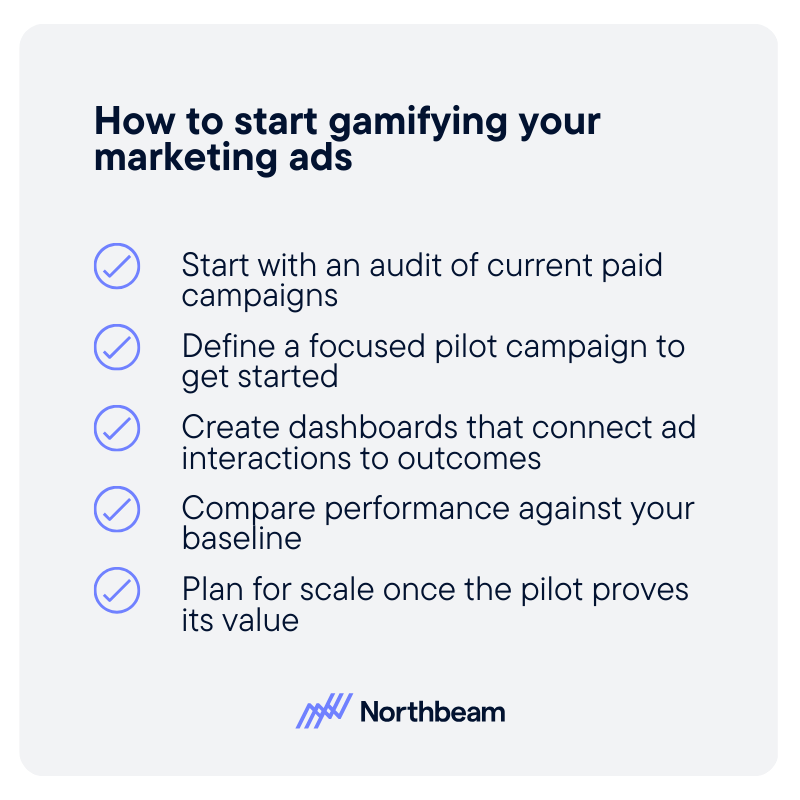
To turn gamified ads into measurable results, teams can follow a structured rollout that balances creative experimentation with attribution discipline:
- Start with an audit of your current paid campaigns. Identify ads with low interaction, high bounce, or unclear attribution paths. Prioritize formats that would benefit most from richer behavioral data.
- Define a focused pilot campaign. Choose one game mechanic and build the interactive experience around it. Specify the micro-events you want to track and confirm your attribution system can ingest them. Establish a clean control or hold-out group to measure incremental lift.
- Create dashboards that connect in-ad interactions to downstream outcomes. Track how events like level complete or coupon unlocked lead to clicks, visits, and conversions. Ensure the data flows smoothly across your multi-touch attribution model.
- Compare performance against your baseline. Evaluate engagement rate, completion rate, conversion rate, incremental ROAS, and attribution share. Look not just at volume but at the quality and predictability of behavioral signals.
- Plan for scale once the pilot proves its value. Refine game mechanics, expand to new channels, and adjust attribution logic to handle additional touchpoints such as shares, referrals, or repeat plays. Continue validating incrementality to ensure you are measuring true impact rather than inflated engagement.
By following these steps, teams can turn gamification into a repeatable growth and measurement lever rather than a one-off creative experiment.
Turn Engagement Into Measurable Growth
Gamification gives paid media teams a powerful way to boost engagement while generating clearer, higher-quality data for attribution.
When every interaction becomes a measurable signal, it becomes easier to understand what truly drives conversions and where to invest next.
If you’re exploring gamified ads for the first time, start small. Run a focused pilot, measure incremental lift, and refine from there.
With the right structure in place, gamification can become a scalable part of your paid strategy.

LinkedIn Segment Reporting: How to Analyze Your Ad Audiences on LinkedIn

Winning marketing campaigns don’t just measure performance, they dig deeper to understand who is engaging and converting.
On LinkedIn, segment reporting makes this possible by turning professional demographics and company information into actionable data for targeting, creative, and budget.
In this context, segment reporting means analyzing campaign performance by specific audience slices: job function, seniority, industry, company size, company list membership, skills, and more.
Instead of relying on aggregate metrics that mask which roles or industries are truly performing, marketers can identify high-value segments and eliminate wasted spend. The result is a clearer picture of which audiences drive real pipeline and revenue.
This article will walk you through how to access LinkedIn’s audience analysis, interpret what the data is telling you, and build a repeatable workflow for segment-level analysis.
By the end, you’ll know not only how to read the reports but also how to act on them: refining targeting, sharpening creative, reallocating budgets, and ultimately delivering better ROI from every campaign.
What Is LinkedIn Segment Reporting & Why It Matters
LinkedIn segment reporting is a structured approach to analyzing campaign performance through the lens of professional demographics and firmographics.
Instead of looking at aggregate results alone, you break performance down by audience slices like job function, seniority, industry, company size, company list membership, skills, and more. This level of granularity shows you not just how campaigns perform overall, but which specific audiences are driving value.
The result is more informed decisions about where to focus your targeting, creative, bids, and budgets.
Why LinkedIn segment reporting matters:
- Precision targeting: Analyze LinkedIn ad audiences by job titles, seniority levels, and industries that generate efficient reach and higher-quality conversions.
- ABM enablement: Validate whether priority accounts and lookalike audiences are truly engaging, then double down where coverage or resonance is strongest.
- Budget clarity: Go beyond broad CPA averages. Reroute dollars toward segments with greater down-funnel impact and ROI.
- Creative guidance: Compare segment-level performance to align headlines, value propositions, and formats with the unique needs of decision-makers.
Segment reporting is the bridge between LinkedIn’s audience analysis data and practical media decisions. By using demographics to optimize LinkedIn ads, you can refine targeting, sharpen creative, and reallocate budgets to the audiences that actually move pipeline and revenue.
Core Tools & Access Paths
If you’re wondering how to segment LinkedIn ad performance, the platform provides multiple ways to dig into audience insights and segment performance.
Whether you’re planning a campaign, optimizing live ads, or scaling through automation, these tools give you the data you need to make informed decisions.
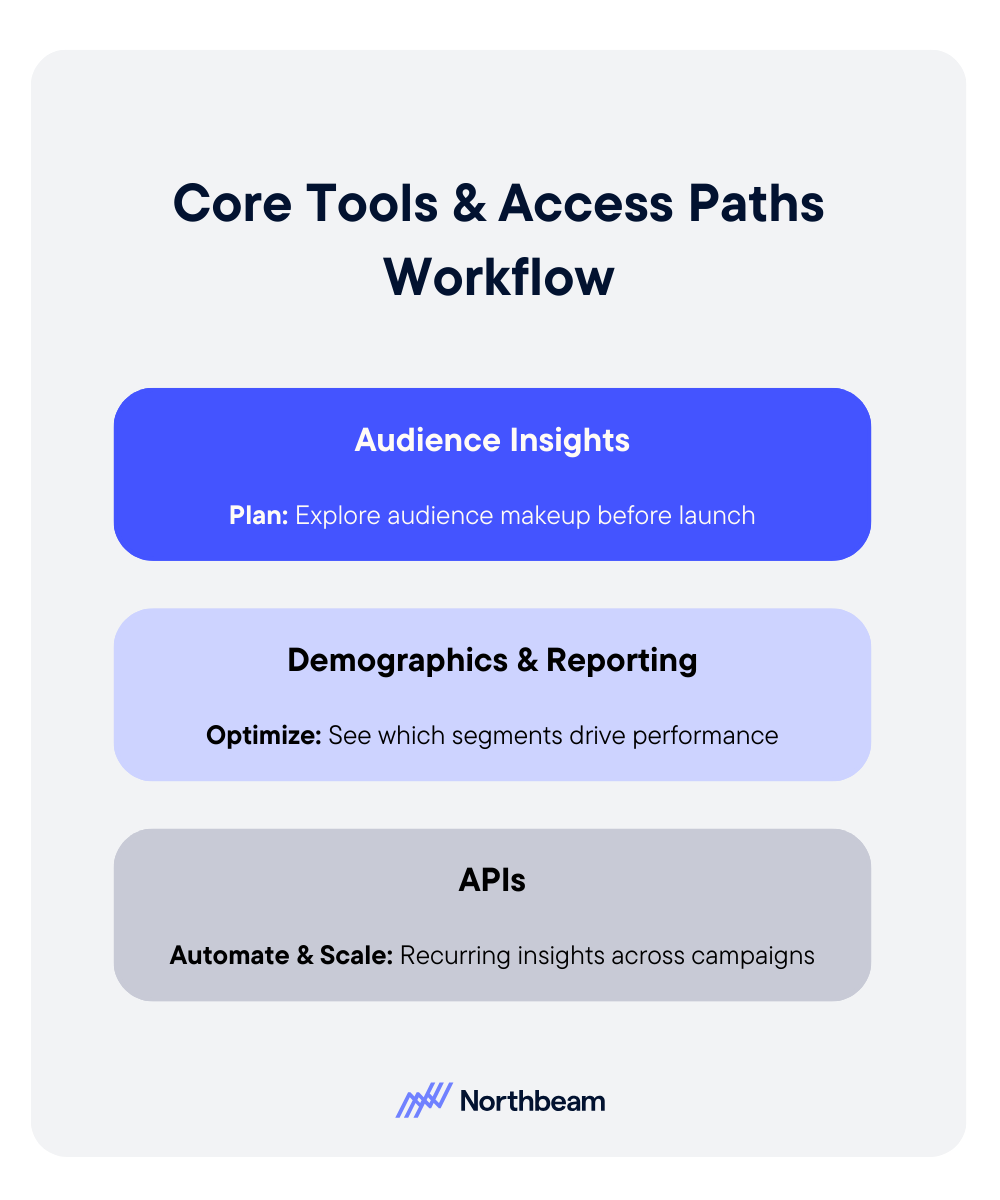
Campaign Manager, Audience Insights (pre-launch and always-on)
Audience Insights helps you understand the makeup of your target audiences before you even launch.
You can explore LinkedIn’s matched audiences reporting, and save audiences by job function, titles, seniority, industry, company size, skills, interests, and more.
This view validates whether your audience definition matches your goals and highlights adjacent segments worth testing.
Campaign Manager, Demographics (live campaigns)
Once campaigns are live, the Demographics tab in Campaign Manager analytics shows which professional cohorts are actually driving performance.
You can break down impressions, engagement, and conversions by job title, seniority, industry, and other factors.
Filters for objective, date range, and campaign hierarchy (account, group, campaign, or ad) make it easy to pinpoint where performance diverges.
Reporting Dashboards & Exports
For deeper analysis, saved reporting views let you track segment-level KPIs such as impressions, CTR, leads, cost per lead, and conversions.
Exporting CSVs makes it simple to compare cohorts across campaigns or over time. Cohort-style tables, broken out by week or month, help you spot durable segment winners rather than short-lived spikes.
APIs (high-level, vendor-neutral)
For advanced teams, LinkedIn Audiences and Linkedin Ad Reporting API endpoints offer programmatic access to demographic breakdowns and performance data.
This is especially valuable for organizations running account based marketing (ABM) programs, frequent experiments, or multi-market rollouts, where standardized dashboards and recurring QA checks are critical.
API reporting for LinkedIn audiences enables automation, ensuring you can scale insights across regions, campaigns, and teams without manual effort.
How to Read & Interpret Segment Reports
Segment reports are most useful when you know which dimensions to focus on and how to separate signal from noise.
By looking beyond surface-level metrics, you can uncover which audiences are actually driving qualified engagement and pipeline.
Key dimensions to monitor include:
- Job function vs. job title: Broad functions reveal trends, while titles give you role-specific nuance.
- Seniority: Helps distinguish between influencers and decision-makers.
- Industry and company size: Pinpoint where your message resonates most strongly.
- Location and account list membership: Ensure coverage in priority markets or ABM lists.
- Skills and interests: Identify emerging pockets of relevance you might not have considered.
Patterns to look for include:
- High engagement, low conversion: Creative resonates but the offer or landing page doesn’t. Test clearer CTAs or deeper content.
- High conversion, low reach: Indicates a strong but narrow segment. Expand with lookalikes, audience growth, or broader title nets within the same function/seniority.
- Seniority spread: If independent contributors click but managers convert, split creative streams to address each layer’s specific challenges and motivations.
- Industry outliers: When certain verticals overperform, spin up industry-specific ads or landing pages to capitalize on momentum.
Common pitfalls to watch out for include:
- Over-segmentation: Tiny cohorts can run into privacy thresholds or lack statistical reliability.
- Mismatched attribution windows: Comparing metrics tracked on different goals or timeframes skews interpretation.
- Short-term spikes: Press coverage or promos can inflate a segment temporarily. Don’t mistake anomalies for durable performance.
The takeaway is that you should read segment reports with both precision and context, with the goal of building a reliable picture of which audiences consistently deliver value.
Strategies & Plays Enabled by Segment Reporting
Segment reporting isn’t just about understanding what happened; it’s about using insights to shape smarter campaigns.
With the right read of audience-level performance, you can refine targeting, sharpen creative, and plan budgets with far more confidence.
Targeting Refinement
Trim underperforming segments, even when their CPAs look “cheap” on the surface. Low-quality leads waste sales resources.
Expand into adjacent roles within high-performing functions. For example, if finance directors perform well, test controllers or VPs with layered seniority filters.
ABM Coverage & Density
Map segment performance against your ABM account lists to see which departments and seniorities are underrepresented.
Build micro-plays tailored to different buying group roles (e.g., economic buyer vs. champion) with distinct messaging and offers.
Creative and Message Testing
Run side-by-side ads for top job functions: leadership messaging vs. operator-level messaging.
Use segment metrics to reveal which value propositions (efficiency, risk reduction, revenue growth) resonate most before scaling spend.
Offer and Format Strategy
If technical roles engage but don’t convert, test deep-dive assets like comparison guides or product sheets.
For executives, emphasize outcomes and ROI. Match ad formats to preferences: document ads for procurement, short videos for time-strapped execs.
Forecasting & planning
Apply historical segment performance to estimate reach, clickthrough rate (CTR), and cost per lead (CPL) at different budget levels by market or vertical.
Prioritize testing in areas with the highest modeled impact on pipeline, not just the cheapest clicks.
Automation & QA
Create a recurring dashboard view (or API-powered workflow) to monitor top segments weekly.
Automate alerts for performance deterioration, surface new opportunities, and track lift after creative refreshes.
Segment reporting transforms guesswork into a repeatable playbook so you can ensure budget and creative energy go where they’ll have the most impact.
Tools, Data, and Setup
The value of segment reporting depends on the quality of your data and the discipline of your setup. Without clean tracking, well-constructed audiences, and a repeatable workflow, insights can easily get muddled or misapplied.
Tracking and Data Hygiene
- Confirm that website and conversion tracking is properly implemented via the LinkedIn pixel or Conversions API.
- Ensure offline conversions and CRM leads sync reliably so that segment learnings tie back to real revenue.
- Standardize UTM parameters across campaigns to reconcile top-of-funnel engagement with down-funnel metrics.
Audience Construction
- Define clear inclusion and exclusion rules for saved and matched audiences. Document naming conventions and change history to maintain transparency.
- Align account lists directly with sales priorities, refreshing them regularly through uploads or connected integrations.
Workflow
- Plan: Validate audiences with Audience Insights and set hypotheses for top segments.
- Launch: Build campaigns with segment-aware ad sets and creative variants.
- Measure: Conduct weekly segment reviews and monthly trend analyses via dashboards or exports.
- Iterate: Promote winners, pause laggards, and adjust creative or landing pages for segment fit.
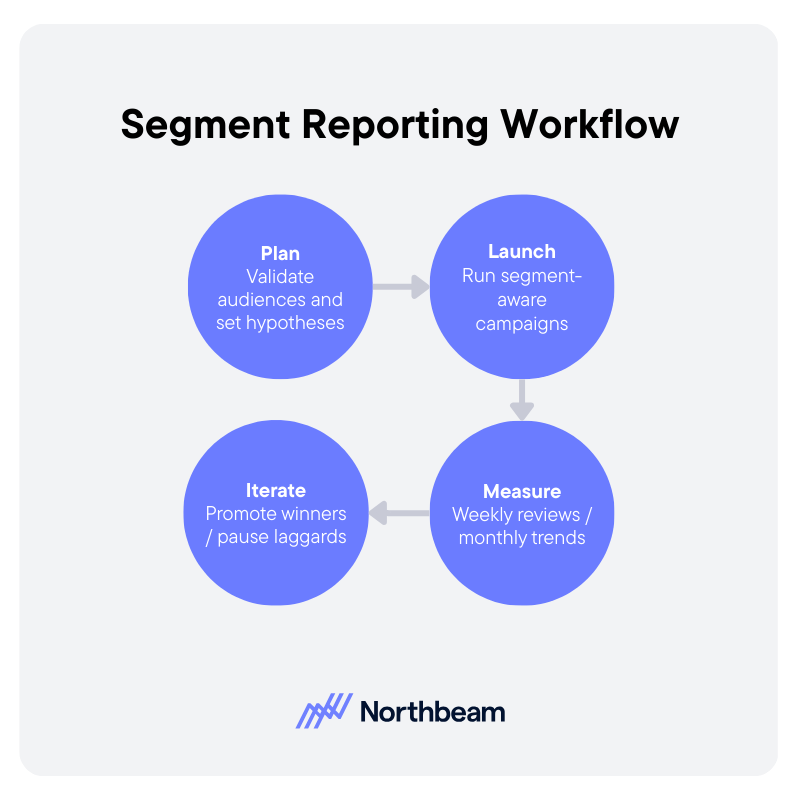
Governance
- Respect LinkedIn’s privacy thresholds and avoid micro-segmentation that produces unreliable data.
- Standardize definitions of key metrics (clicks, leads, pipeline stages) and attribution windows across marketing and sales teams to ensure consistency.
By combining clean data, disciplined audience design, and a structured workflow, segment reporting becomes a reliable engine for ongoing optimization rather than a one-off analysis.
Implementation Considerations
Even the best tools and workflows won’t deliver results without clear standards and disciplined execution.
To make segment reporting sustainable, marketers need shared definitions, a consistent cadence, and guardrails that keep analyses meaningful.
Shared Definitions
- Establish canonical lists for job functions, titles, and industries, with clear rules for how to roll up smaller cohorts.
- Standardize audience and campaign naming conventions, and keep version logs whenever targeting or creative changes occur.
Cadence
- Run weekly optimization cycles using segment-level reads.
- Conduct monthly or quarterly reviews of audience mix by market and vertical to spot broader trends.
KPIs by Goal
- Awareness: Reach, frequency, and qualified engagement rate by segment.
- Acquisition: CTR, CPL, conversion rate, and cost-per-qualified-lead by segment.
- Pipeline: Lead-to-opportunity rate and cost-per-opportunity by segment.
- Efficiency: Incremental lift after creative or offer changes, plus payback period trends.
Risk management
- Set guardrails for minimum audience sizes to avoid over-fragmentation and unreliable data.
- Account for seasonality and macro events when comparing month-over-month segment performance.
With disciplined definitions, cadence, and guardrails, segment reporting becomes a reliable source of insights and consistent performance gains.
Turning Insights Into Action
Segment reporting cuts through the noise of aggregate metrics to show which professional audiences (by title, seniority, industry, and beyond) are truly driving performance.
These insights aren’t just descriptive; they enable smarter targeting, sharper creative, and more efficient budget allocation across every stage of the funnel.
To make the most of LinkedIn’s ad reporting capabilities, keep it simple:
- Commit to a weekly routine. Review your top-performing segments, refresh one creative or targeting variable, and adjust budgets accordingly.
- Save a go-to Audience Insights view. For example, segment by job function and industry, and dedicate 20 minutes each week to check in on performance.
By treating segment reporting as an ongoing habit rather than a one-off analysis, you build a repeatable system for turning LinkedIn’s demographic depth into measurable growth.
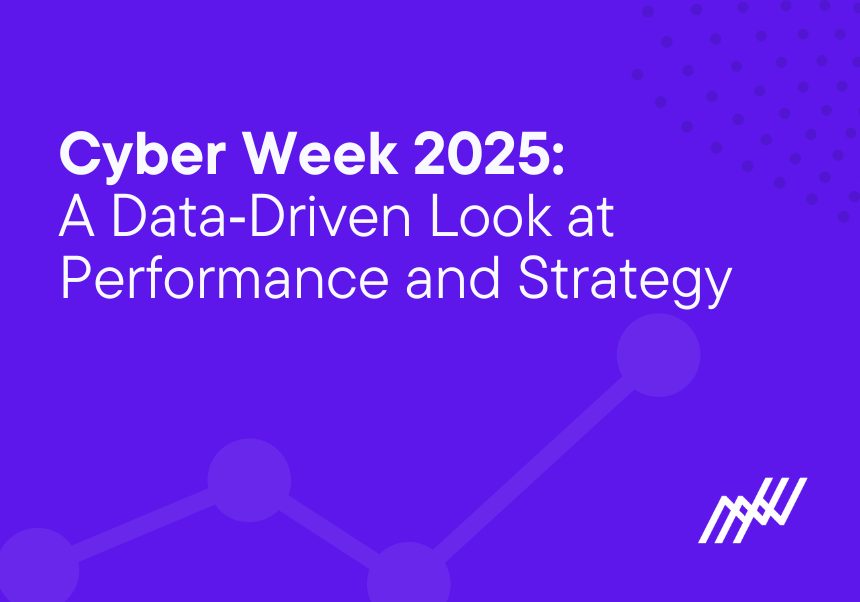
Cyber Week 2025: A Data‑Driven Look at Performance and Strategy

This article, our associated whitepaper, and the webinar I hosted, are based on Northbeam’s internal proprietary Clicks-Only data.
For DTC brands, Cyber Week 2025 wasn’t just “another record year.” It was a clear signal that peak season is now a strategy game, not a “spend big and hope for the best” game.
Across Northbeam’s customer base, we saw ad spend rise by just over 9% year over year, while revenue grew more than 13%, lifting MER even as first‑time CAC climbed about 8%. In other words: shoppers are still willing to buy, but they’re a lot more selective about when and how they convert.
This blog is a high‑level walkthrough of what we saw across thousands of DTC brands during Cyber Week 2025, and how the best teams are already adjusting their playbooks for 2026.
If you want the full channel‑by‑channel, industry, and company‑size breakdowns, grab the report this blog is based on:
Get the full data set: Download the BFCM 2025: The Report whitepaper for all charts, daily breakdowns, and industry cuts.
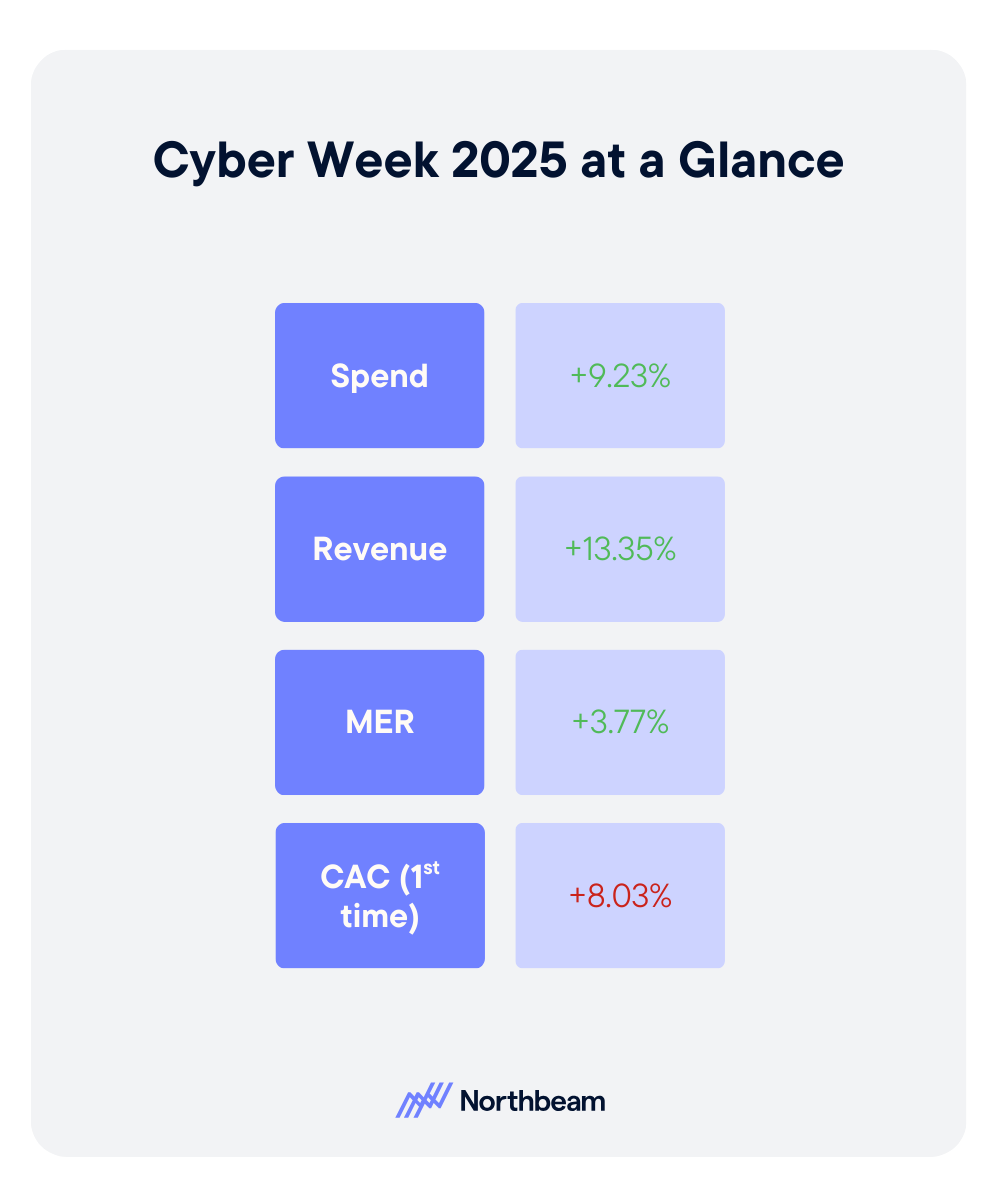
1. The window keeps widening: seed early, harvest late
Long gone are the days of lining up outside a big‑box retailer at midnight. The in‑store moment may have faded, but the online punch of Black Friday/Cyber Monday is absolutely still there, it just starts earlier and stretches longer.
When we looked at the 21‑day run‑up to Cyber Week (Nov 4–24), a few things stood out:
- Brands increased spend in the lead‑up; roughly mid‑single digits overall.
- Revenue in that same period grew a bit faster than spend.
- First‑time CAC jumped sharply, into the mid‑teens percentage‑wise.
Put simply, advertisers were priming the pump. They were willing to pay more to get in front of new customers before the sale, knowing that a meaningful chunk of that demand would only convert once the “real” offers went live.
That’s conversion lag in practice:
Dollars spent early in November convert during the sale itself, sometimes days or even weeks later.
If you only look at 1‑day click ROAS in‑platform, this early‑month spend can look terrible. When you look at it through a multi‑touch, cross‑channel lens, it suddenly becomes clear that your “expensive” pre‑BFCM dollars are actually doing a lot of the heavy lifting for peak week performance.
In the full report: we break down the Nov 4–24 period in more detail and show exactly how spend, revenue, MER, and first‑time CAC moved during those three weeks.
Watch the full webinar I hosted right here!
2. Cyber Week is a week‑long arc, not a single spike
From a distance, Cyber Week still looks like what you’d expect: spend ramps into Black Friday, stays elevated through Cyber Monday, then cools off. But when you zoom in day‑by‑day, the pattern is a lot more instructive.
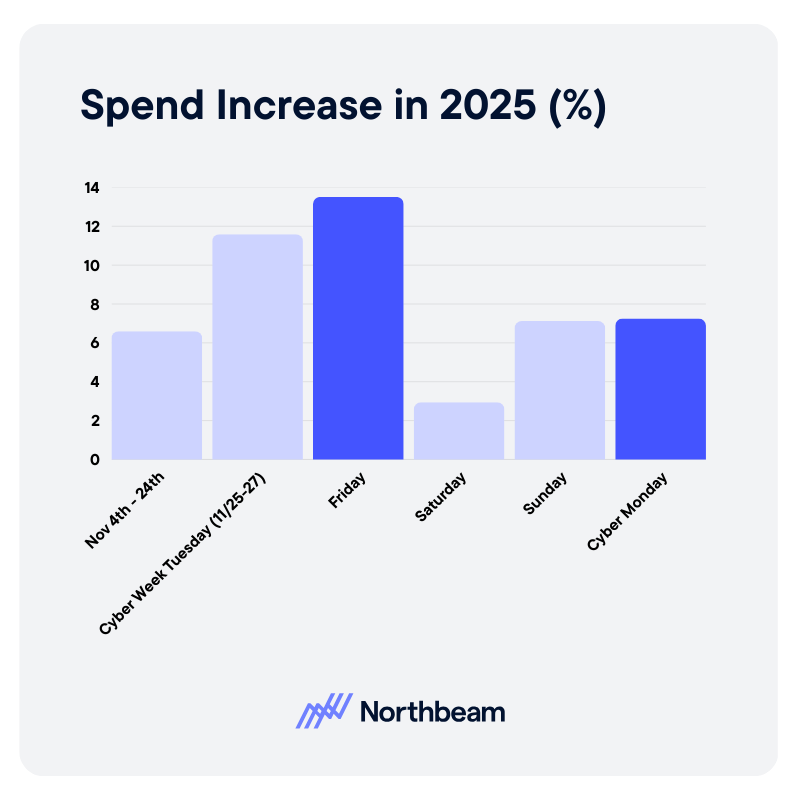
Here’s the simplified version of what we saw:
- Tue–Thu (pre–Black Friday)
Brands ramped into the peak. Spend and revenue both moved up double‑digits vs. last year, MER improved modestly, and CAC started to climb as consumers browsed and waited. - Black Friday
Still the single biggest spend day of the week, but also the point where efficiency compressed the most. MER dipped relative to 2024 while CAC jumped by the mid‑teens as auctions got crowded and everyone piled in at once. - Saturday & Sunday
Many brands pulled back on spend on Saturday, and MER actually rebounded as the most motivated shoppers kept converting. By Sunday, both spend and revenue started to pick up again heading into Monday. - Cyber Monday
Spend re‑accelerated and efficiency improved vs. Black Friday, MER climbed, and CAC rose more modestly. This is the “I’ve been browsing all weekend and I’m finally pulling the trigger” behavior we heard anecdotally across accounts.
This is why we’re pushing clients to stop thinking in terms of “What’s my Black Friday budget?” and start thinking in terms of “What’s my Cyber Week arc?”
Some practical implications:
- You don’t need to front‑load 100% of your aggression into Friday. If you’re not seeing the results you expected, there’s a strong case for shifting some budget into Sunday/Monday next year, where competition can be slightly softer and intent is still high.
- When you evaluate performance, judge the week as a system, not as isolated days. A “weak” Thursday on a click‑only view might be exactly what you need to make Monday a record day.
3. Meta and Google still own the spine, but diversification is real
Despite all the noise about new platforms, Meta and Google are still the foundation of DTC performance marketing during Cyber Week.
Across our dataset:
- Together, Meta and Google represented roughly 80% of Cyber Week digital ad spend.
- Both platforms delivered strong revenue growth year over year and improvements (or stability) in short‑window ROAS, even as overall auctions remained competitive.
In other words: if you’re trying to build a BFCM media plan without Meta and Google as your budget spine, you’re swimming upstream.
That said, we did see meaningful wallet‑share movement elsewhere:
- TikTok: Brands significantly increased spend here, and revenue kept pace, especially for those willing to lean into video‑heavy prospecting and measure impact with Clicks + Deterministic Views (C+DV) instead of click‑only.
- Pinterest: Also saw solid budget growth. Performance was more mixed across accounts, but for visual, giftable categories, Pinterest remained a strong discovery and conversion assist channel.
- YouTube: Interestingly, we saw a slight decline in wallet share but much stronger revenue growth and ROAS among brands that stuck with it — alongside significantly cheaper CPMs. To us, that’s a classic sign of a channel that looks “meh” in last‑click, but quietly delivers revenue when you look at it through a multi‑touch lens.
The core takeaway:
Use emerging channels to diversify reach, not to “replace” Meta/Google.
Your job is to build a spine (Meta + Google), then layer in TikTok, Pinterest, YouTube, Snap, etc. in a way that actually adds incremental lift rather than just cannibalizing what you already have.
In the full report: we show detailed wallet share shifts, CPM/ROAS changes by platform, and a simple set of “rules of thumb” for how much budget most brands are safely putting into each non‑core channel today.
4. Size and category dictated who actually “won” Cyber Week
On aggregate, Cyber Week looks great. Under the hood, performance diverged sharply by company size and industry.
By company size
When we segmented brands by annual revenue, three different stories emerged:
- Large brands (>$100M)
- Spend up high single digits.
- Revenue up mid‑teens.
- MER up meaningfully, with only a small CAC increase.
- These teams tended to have their BFCM strategy dialed in — from promo structure to channel mix to upper‑funnel measurement.
- Mid‑market brands ($10M–$100M)
- Biggest increase in investment.
- The sharpest spike in CAC.
- MER roughly flat year over year.
- Growth was there, but it often came without efficiency gains. These are the brands that felt the most pressure from auction dynamics.
- Smaller brands (<$10M)
- More cautious on spend.
- Modest revenue lift.
- Small MER improvements, but less ability to simply “buy their way” into the peak.
By industry
We also saw clear category‑level winners and laggards:
- Strong performers:
- Beauty & Personal Care — grew spend and revenue, while actually improving first‑time CAC, making it one of the standout categories this year.
- Fashion & Accessories — consumers rewarded increased investment with outsized revenue growth; still a core Q4 gifting engine.
- Home & Furniture — solid returns suggest that considered, higher‑ticket purchases still respond well to strong seasonal offers.
- Sporting Goods & Fitness — brands that pulled back spend actually improved unit economics significantly, creating room to re‑invest smarter in 2026.
- Slower performers:
- Food & Beverage — advertisers pulled back, which helped stabilize MER, but rising CAC and modest revenue growth point to a tougher environment.
- Health & Wellness — arguably the most challenged category in the dataset: heavy investment, softer revenue, sharply higher CAC. Many brands tried to pull forward their usual Q1 “new year, new me” demand into Cyber Week — and it didn’t fully pay off.
The key message:
Your BFCM strategy has to be category‑specific. Elasticity, gifting dynamics, purchase frequency, and payback windows are wildly different by vertical — your benchmarks and budget ladders should be, too.
5. What to do now: four moves before you plan BFCM 2026
Coming out of Cyber Week, here’s how I’d recommend you operationalize these learnings.
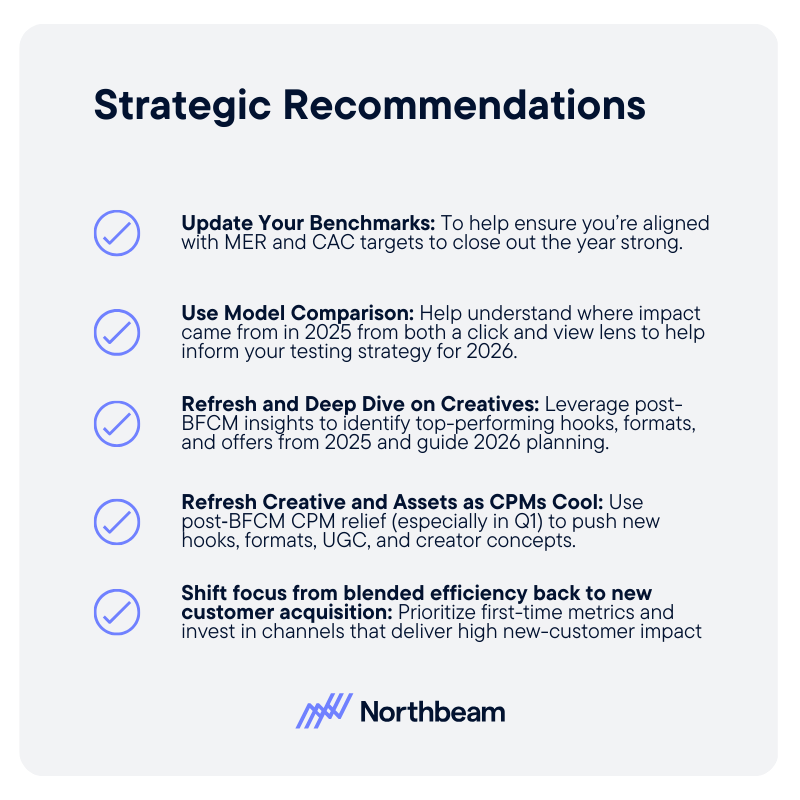
1. Reset your benchmarks
Your “peak week” numbers are already out of date. Update:
- MER and CAC targets back to a more business‑as‑usual range.
- Channel‑level ROAS guardrails so your teams don’t keep optimizing to Black Friday conditions in January.
If you’re with Northbeam, this is a great time to align your Benchmarks/Stoplights with what “good” actually looks like post‑BFCM.
2. Use model comparison to understand what really drove 2025
If you only look at click‑only models, you’ll wildly underestimate:
- Upper‑funnel channels like TikTok, YouTube, Snapchat.
- Video‑heavy and creator/UGC campaigns.
- The early‑November “seed” campaigns that set up your Cyber Week harvest.
Swap between Clicks‑Only and Clicks + Deterministic Views (C+DV) in your reporting to see where net‑new demand actually came from in 2025, and use that to inform where you test harder in 2026.
3. Test smarter with MMM and incrementality
Media mix modeling (MMM) and incrementality testing have gone from “nice to have” to non‑negotiable:
- Use MMM to re‑forecast your 2026 channel mix based on what worked in 2025 — especially if you’re trying to push into new channels without blowing up CAC.
- Use incrementality tests to validate that your “growth channels” are actually adding incremental revenue, not just shifting credit around. Northbeam’s new incrementality solution also feeds those learnings back into MMM, so your model gets smarter, faster.
4. Lean back into creative and asset experimentation as CPMs cool
CPMs almost always cool off post‑BFCM, especially in Q1. That’s your window to:
- Launch new hooks, formats, and UGC concepts across your highest‑elasticity categories.
- Refresh offers and funnels for categories that struggled this year (looking at you, health & wellness and F&B) before you repeat 2025’s spend levels.
- Systematically log top‑performing creative from 2025 so you’re not reinventing the wheel next November.
Want the full data and all the charts?
This blog barely scratches the surface of what we saw in the data.
If you’re planning budgets for 2026 — or just trying to sanity‑check how your brand stacked up — I’d strongly recommend digging into the full whitepaper:
Download the full BFCM 2025: The Report to get:
- Day‑by‑day Cyber Week performance (Tue–Mon)
- Channel mix and wallet‑share shifts, including TikTok, Pinterest, YouTube, Snap, and more
- Performance by company size and industry, with detailed MER and CAC changes
- A deeper dive on how to use C+DV, MMM, and incrementality together
Cyber Week 2025 made one thing clear: the demand is still there — but the brands that win are the ones that plan, measure, and adapt smarter than everyone else.

Follow us














.svg)
